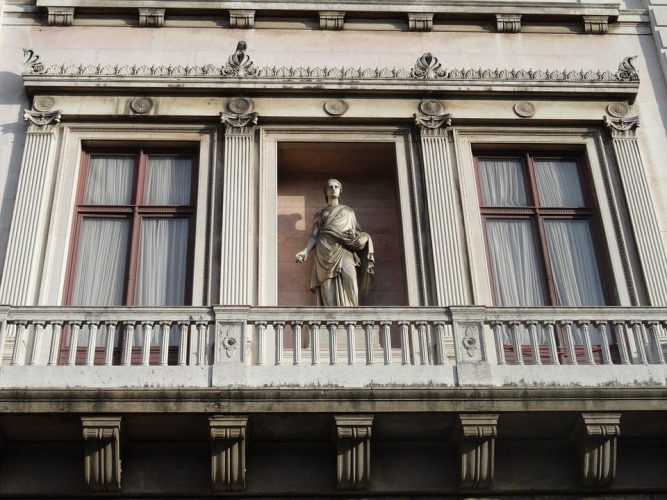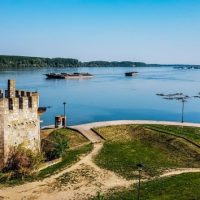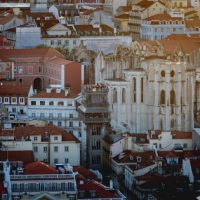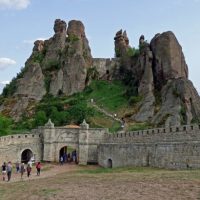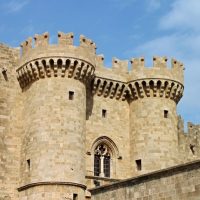Brazil is the largest country in South America, so there’s a lot of land to cover.
And you better believe that much of that land is covered with architectural wonders.
There are over a dozen castles throughout the country from various centuries.
Whether they are still standing or in ruins, they can provide you with a glimpse into some of the histories of the country.
13 Most Beautiful Castles in Brazil
Castles throughout Brazil can look very different from those in Europe due to the Latin influences.
As such, you can see a significant number of architectural types as you explore the castles.
Castle of the Baron of Itaipava
This castle is commonly known simply as the Itaipava Castle and was constructed in the early 1900s.
It was made completely of materials sourced from Europe and took approximately five years to complete.
While it is not moated, there is a large pool with a drawbridge at the front entrance.
Aristocrat Rodolfo Smith de Vasconcellos was the one who built the castle.
Throughout the premises, there are various attractions that bring in tourists from around the world, including a brewery with its own exclusive beer recipe as well as a beauty center and Solar do Castelo.
Castelo Lacave
The Castelo Lacave is interesting because it also functions as a winery.
It was built in 1978 by an individual who had the desire to construct a 6th-century castle within the Caxias do Sul city limits.
It was constructed of basalt stone without any cement used.
In 1987, the original owner died. Since then, it has changed owners throughout the years.
Today, the castle is open to show the stages of wine production – and most tours end with a wine tasting. Additionally, there are many items on display as if the castle came from the 6th century, including thrones, crests, and medieval armor.
Tax Island Castle
Tax Island Castle is unique for a number of reasons.
It is one of the oldest, having been built in the 1800s.
It is found in the interior of Guanabara Bay and resides on the border of the historic center of Rio de Janeiro.
It is also highly recognized for being a waterfront castle with lots of arches.
The castle is famous for being the last Ball of Ilha Fiscal, a party of the Empire prior to the Proclamation of the Republic happening in November of 1889.
Castelo da Torre de Garcia D’Avila
This 17th-century building is commonly known as The Tower House of Garcia d’Avila.
It was constructed in what is now Praia do Forte.
It is only 1200 meters from the coastline of the harbor of the Atlantic Ocean, offering stunning waterfront views.
Tome de Sousa was the first governor-general of Brazil and appointed his son Garcia d’Avila to build a fortress.
The result was a castle, watchtower, and church.
While in ruins today, it was designated to the National Historic Heritage of Brazil in 1938.
Castelo Arautos de Evanghelo
This castle is a well-known religious site within the area of Ubatuba.
It is commonly known as the Heralds of the Gospel and offers a chapel with polychrome graphic details throughout.
It is possible to attend mass as well as to take a scheduled tour of the location.
Gothic and medieval architecture come together to span the building which is nearly 9,000 square meters.
Inside, you will see chandeliers, religious art, stained glass windows, and more.
The design of the castle and chapel was intended to raise the faithful to God.
Castelinho da Havan
Castelinho da Havan is found in Blumenau.
It is actually one of the most photographed attractions in southern Brazil, which is a testament to not only the architecture but also the German roots.
The timber framing style has been beautifully preserved.
The exterior of the building was designed to be a replica of the south German Michelstadt city hall.
The inside of the building is actually a department store.
It’s open to the public, making it easy to shop for everything from clothing to housewares, and the store is open all days except for Sundays.
Castle of Pedra Altas
Within the Rio Grande do Sul, there is the Pedra Altas Castle.
It was built during the years of 1909 to 1913.
It was inspired by medieval architecture and was built for Joaquim Francisco de Assis Brasil, who was a diplomat who wanted to move into a country property.
The castle is nestled into an area that is lush with greenery.
Several smaller buildings are found in the back of the property.
It is open to the public as many believe it is representative of the region’s history.
Today, the site is listed by the Institute of Historic and Artistic Heritage of the State.
Castle of Batel
The Castle of Batel is considered one with the most grandeur.
It is located in Curitiba within the province of Parana.
Coffee grower Luiz Guimaraes was the one who conceived the design and was inspired by French construction throughout the Loire Valley region.
The castle was finished in 1928 and many considered it to be a unique design with many windows and arches.
There’s also a large, landscaped area surrounding the building.
Upon construction, the castle has been frequented by the Mayor of Curitiba Joao Moreira Garces as well as former Italian minister Count Dino Grandi, among many others.
Santa Cruz da Barra Fortress
Located in the Jurujuba area of Rio de Janeiro, the fortress encompasses an entire compound of buildings.
It served as one of the main coastal defenses in Guanabana Bay over 300 years ago.
It was renamed in 1612 and contains a significant number of military artifacts and memorabilia ranging from battery canons to bronze bullets.
There are tours that will take people through the Chapel of Santa Barbara, the dungeon cells, the watchtowers, and even the lighthouse.
There is also a sundial on the premises that has become quite famous, which was added to the property in 1820.
Catete Palace
The Catete Palace is found in the Flamengo neighborhood of Rio de Janeiro.
It is an urban mansion that was constructed between 1858 and 1867.
Beginning in 1897, it was the presidential palace and stayed that way until 1960.
It is also the site of the suicide of Getulio Vargas in 1954, the president of Brazil at the time.
Today, it is now a theater and houses the Museum of the Republic, which is where presidential memorabilia and period art is on display.
It is open to the public, and the Catete underground rail station is adjacent to the property.
Sao Marcelo do Mar Fort
Located in Bahia, Brazil, the Sao Marcelo do Mar Fort is on a small island off the coast of the Baia de Todos os Santos.
It is one of only two forts in the country that are separated by water from mainland Brazil.
The design is similar to the Castle of St. Angelo in Italy as well as the Sao Lourenco do Bugio Fort in Portugal.
Many visitors refer to the castle simply as the “Forte do Mar” or Fort of the Sea.
The reason the castle was built was to protect the port city of Salvador from any external threats.
Palace of the Dawn
The term “castle” is used loosely when describing the Palace of the Dawn.
It is absolutely beautiful, but it doesn’t have the traditional medieval look when you consider castles.
It has a modern feel, being designed by Oscar Niemeyer between 1957 and 1958.
The castle is found in the capital of Brasilia and is the official residence of the Brazilian president.
Every president since Juscelino Kubitschek has lived here and it is listed as a National Historic Heritage Site.
It is possible to visit the outside of the building, but tours are not provided throughout the interior.
Fortress of Three Wise Men
The Fortress of Three Wise Men is also known as the Forte dos Reis Magos.
It is located in Natal and looks out over the Potengi River.
The name was given based on when it commenced construction – December 1599.
The fortress was one of the first milestones of the city of Natal.
While it is no longer a functioning fort, many people love to go to the site because of the architectural history that is present.
Many components of the fort are still standing, and it also provides stunning views of some of the neighboring cities.
Brazil Safety Overview
READ THE FULL REPORT: Brazil Safety Review
Safety Index:
- OVERALL RISK: MEDIUM
- TRANSPORT & TAXIS RISK: MEDIUM
- PICKPOCKETS RISK: MEDIUM
- NATURAL DISASTERS RISK: MEDIUM
- MUGGING RISK: MEDIUM
- TERRORISM RISK: LOW
- SCAMS RISK: MEDIUM
- WOMEN TRAVELERS RISK: MEDIUM
Frequently Asked Questions
Are there castles for sale in Brazil?
Castles that are privately owned can go up for sale at any time.
If you are interested in buying a castle, it would be a good idea to work with a realtor who specializes in luxury homes and estates.
Does it cost to visit the castles in Brazil?
Many of the castles are open to the public and do not cost unless you choose to see them as part of a guided tour.
Any castles that are not open are because they are either private residences or in ruins.
What is the oldest castle in Brazil?
Some of the oldest castles throughout Brazil were constructed several hundred years ago.
The oldest where there are still ruins that can be visited is the Fortress of Three Wise Men.
Were all castles owned by royalty?
No.
Many of the castles were privately owned.
Additionally, many “castles” were actually forts as a way to provide safety from military attacks.
What is one of the newer castles in Brazil?
The Coradelli castle was built in the northern part of Santa Catarina in 1996.
It was privately constructed but many were interested in visiting before construction finished.
There are currently 16 large towers and 32 smaller ones, though many believe that the construction is still not entirely finished.
What city has the most castles in Brazil?
In and around Rio de Janeiro is where you’ll find the most castles.
The reason for this is that the capital city also played an important role during the Empire.
